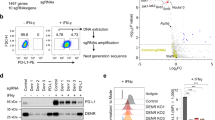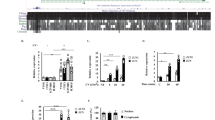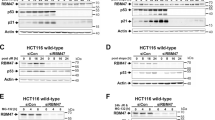Abstract
Ribonuclease L (RNase L) is an intracellular enzyme that is vital in innate immunity, but also is a tumor suppressor candidate. Here, we show that overexpression of RNase L decreases cellular growth and downmodulates the RNA-binding protein, HuR, a regulator of cell-cycle progression and tumorigenesis. The effect is temporal, occurring in specific cell-cycle phases and correlated with the cytoplasmic localization of RNase L. Both cellular growth and HuR were increased in RNASEL-null mouse fibroblast lines when compared to wild-type cells. Moreover, the stability of HuR mRNA was enhanced in RNASEL-null cells. The HuR 3′ untranslated region (UTR), which harbors U-rich and adenylate-uridylate-rich elements, was potently responsive to RNase L when compared to control 3′ UTR. Our results may offer a new explanation to the tumor suppressor function of RNase L.
This is a preview of subscription content, access via your institution
Access options
Subscribe to this journal
Receive 50 print issues and online access
$259.00 per year
only $5.18 per issue
Buy this article
- Purchase on Springer Link
- Instant access to full article PDF
Prices may be subject to local taxes which are calculated during checkout






Similar content being viewed by others
References
Al-Zoghaibi F, Ashour T, Al-Ahmadi W, Abulleef H, Demirkaya O, Khabar KS . (2007). Bioinformatics and experimental derivation of an efficient hybrid 3′ untranslated region and use in expression active linear DNA with minimum poly(A) region. Gene 391: 130–139.
Andersen JB, Li XL, Judge CS, Zhou A, Jha BK, Shelby S et al. (2007). Role of 2-5A-dependent RNase-L in senescence and longevity. Oncogene 26: 3081–3088.
Atasoy U, Watson J, Patel D, Keene JD . (1998). ELAV protein HuA (HuR) can redistribute between nucleus and cytoplasm and is upregulated during serum stimulation and T cell activation. J Cell Sci 111: 3145–3156.
Bayard BA, Gabrion JB . (1993). 2′,5′-Oligoadenylate-dependent RNAse located in nuclei: biochemical characterization and subcellular distribution of the nuclease in human and murine cells. Biochem J 296 (Part 1): 155–160.
Bisbal C, Silhol M, Laubenthal H, Kaluza T, Carnac G, Milligan L et al. (2000). The 2′-5′ oligoadenylate/RNase L/RNase L inhibitor pathway regulates both MyoD mRNA stability and muscle cell differentiation. Mol Cell Biol 20: 4959–4969.
Carpten J, Nupponen N, Isaacs S, Sood R, Robbins C, Xu J et al. (2002). Germline mutations in the ribonuclease L gene in families showing linkage with HPC1. Nat Genet 30: 181–184.
Castelli JC, Hassel BA, Maran A, Paranjape J, Hewitt JA, Li XL et al. (1998). The role of 2′-5′ oligoadenylate-activated ribonuclease L in apoptosis. Cell Death Differ 5: 313–320.
Cirino NM, Li G, Xiao W, Torrence PF, Silverman RH . (1997). Targeting RNA decay with 2′,5′ oligoadenylate-antisense in respiratory syncytial virus-infected cells. Proc Natl Acad Sci USA 94: 1937–1942.
Denkert C, Weichert W, Pest S, Koch I, Licht D, Kobel M et al. (2004). Overexpression of the embryonic-lethal abnormal vision-like protein HuR in ovarian carcinoma is a prognostic factor and is associated with increased cyclooxygenase 2 expression. Cancer Res 64: 189–195.
Diaz-Guerra M, Rivas C, Esteban M . (1997). Activation of the IFN-inducible enzyme RNase L causes apoptosis of animal cells. Virology 236: 354–363.
Dormoy-Raclet V, Menard I, Clair E, Kurban G, Mazroui R, Di Marco S et al. (2007). The RNA-binding protein HuR promotes cell migration and cell invasion by stabili. Mol Cell Biol 27: 5365–5380.
Frevel MA, Bakheet T, Silva AM, Hissong JG, Khabar KS, Williams BR . (2003). p38 Mitogen-activated protein kinase-dependent and -independent signaling of mRNA stability of AU-rich element-containing transcripts. Mol Cell Biol 23: 425–436.
Gallouzi IE, Brennan CM, Stenberg MG, Swanson MS, Eversole A, Maizels N et al. (2000). HuR binding to cytoplasmic mRNA is perturbed by heat shock. Proc Natl Acad Sci USA 97: 3073–3078.
Heinonen M, Bono P, Narko K, Chang SH, Lundin J, Joensuu H et al. (2005). Cytoplasmic HuR expression is a prognostic factor in invasive ductal breast carcinoma. Cancer Res 65: 2157–2161.
Jacobsen H, Krause D, Friedman RM, Silverman RH . (1983). Induction of ppp(A2′p)nA-dependent RNase in murine JLS-V9R cells during growth inhibition. Proc Natl Acad Sci USA 80: 4954–4958.
Keene JD . (1999). Why is Hu where? Shuttling of early-response-gene messenger RNA subsets. Proc Natl Acad Sci USA 96: 5–7.
Khabar KS, Al-Haj L, Al-Zoghaibi F, Marie M, Dhalla M, Polyak SJ et al. (2004). Expressed gene clusters associated with cellular sensitivity and resistance towards anti-viral and anti-proliferative actions of interferon. J Mol Biol 342: 833–846.
Khabar KS, Dhalla M, Siddiqui Y, Zhou A, Al-Ahdal MN, Der SD et al. (2000). Effect of deficiency of the double-stranded RNA-dependent protein kinase, PKR, on antiviral resistance in the presence or absence of ribonuclease L: HSV-1 replication is particularly sensitive to deficiency of the major IFN-mediated enzymes. J Interferon Cytokine Res 20: 653–659.
Khabar KS, Siddiqui Y, Dhalla D, Al-Ahdal MN, al-Zoghaibi F, Zhou A et al. (1999). Constitutive and IFN-induced antiviral enzyme activities: expected and surprising consequences in gene-devoid fibroblasts. J Interferon Cytokine Res 19: 68. Annual Meeting of Interferon and Cytokine Research. Liebert, New York.
Khabar KS, Siddiqui YM, al-Zoghaibi F, al-Haj L, Dhalla M, Zhou A et al. (2003). RNase L mediates transient control of the interferon response through modulation of the double-stranded RNA-dependent protein kinase PKR. J Biol Chem 278: 20124–20132.
Kumar R, Choubey D, Lengyel P, Sen GC . (1988). Studies on the role of the 2′-5′-oligoadenylate synthetase-RNase L pathway in beta interferon-mediated inhibition of encephalomyocarditis virus replication. J Virol 62: 3175–3181.
Kumar R, Korutla L, Zhang K . (1994). Cell cycle-dependent modulation of alpha-interferon-inducible gene expression and activation of signaling components in Daudi cells. J Biol Chem 269: 25437–25441.
Lal A, Mazan-Mamczarz K, Kawai T, Yang X, Martindale JL, Gorospe M . (2004). Concurrent versus individual binding of HuR and AUF1 to common labile target mRNAs. EMBO J 23: 3092–3102.
Li XL, Andersen JB, Ezelle HJ, Wilson GM, Hassel BA . (2007). Post-transcriptional regulation of RNase-L expression is mediated by the 3′-untranslated region of its mRNA. J Biol Chem 282: 7950–7960.
Li XL, Blackford JA, Hassel BA . (1998). RNase L mediates the antiviral effect of interferon through a selective reduction in viral RNA during encephalomyocarditis virus infection. J Virol 72: 2752–2759.
Li XL, Blackford JA, Judge CS, Liu M, Xiao W, Kalvakolanu DV et al. (2000). RNase-L-dependent destabilization of interferon-induced mRNAs. A role for the 2-5A system in attenuation of the interferon response. J Biol Chem 275: 8880–8888.
Liu W, Liang SL, Liu H, Silverman R, Zhou A . (2007). Tumour suppressor function of RNase L in a mouse model. Eur J Cancer 43: 202–209.
Lopez de Silanes I, Fan J, Yang X, Zonderman AB, Potapova O, Pizer ES et al. (2003). Role of the RNA-binding protein HuR in colon carcinogenesis. Oncogene 22: 7146–7154.
Malathi K, Dong B, Gale M, Jr, Silverman RH . (2007). Small self-RNA generated by RNase L amplifies antiviral innate immunity. Nature 448: 816–819.
Mazan-Mamczarz K, Hagner PR, Corl S, Srikantan S, Wood WH, Becker KG et al. (2008). Post-transcriptional gene regulation by HuR promotes a more tumorigenic phenotype. Oncogene 27: 6151–6163.
Molinaro RJ, Jha BK, Malathi K, Varambally S, Chinnaiyan AM, Silverman RH . (2006). Selection and cloning of poly(rC)-binding protein 2 and Raf kinase inhibitor protein RNA activators of 2′,5′-oligoadenylate synthetase from prostate cancer cells. Nucleic Acids Res 34: 6684–6695.
Mrena J, Wiksten JP, Thiel A, Kokkola A, Pohjola L, Lundin J et al. (2005). Cyclooxygenase-2 is an independent prognostic factor in gastric cancer and its expression is regulated by the messenger RNA stability factor HuR. Clin Cancer Res 11: 7362–7368.
Silverman RH . (2003). Implications for RNase L in prostate cancer biology. Biochemistry 42: 1805–1812.
Solly K, Wang X, Xu X, Strulovici B, Zheng W . (2004). Application of real-time cell electronic sensing (RT-CES) technology to cell-based assays. Assay Drug Dev Technol 2: 363–372.
Stark GR, Kerr IM, Williams BR, Silverman RH, Schreiber RD . (1998). How cells respond to interferons. Annu Rev Biochem 67: 227–264.
Subbaramaiah K, Marmao TP, Dixon DA, Dannenberg AJ . (2003). Regulation of cyclooxygenase-2 mRNA stability by taxanes. Evidence for involvement of p38, MAPKAPK-2 and HuR. J Biol Chem 25: 25.
Tran H, Maurer F, Nagamine Y . (2003). Stabilization of urokinase and urokinase receptor mRNAs by HuR is linked to its cytoplasmic accumulation induced by activated mitogen-activated protein kinase-activated protein kinase 2. Mol Cell Biol 23: 7177–7188.
Urisman A, Molinaro RJ, Fischer N, Plummer SJ, Casey G, Klein EA et al. (2006). Identification of a novel gammaretrovirus in prostate tumors of patients homozygous for R462Q RNASEL variant. PLoS Pathog 2: e25.
van der Giessen K, Di-Marco S, Clair E, Gallouzi IE . (2003). RNAi-mediated HuR depletion leads to the inhibition of muscle cell differentiation. J Biol Chem 278: 47119–47128.
Wang Q, Carmichael GG . (2004). Effects of length and location on the cellular response to double-stranded RNA. Microbiol Mol Biol Rev 68: 432–452.
Wang W, Furneaux H, Cheng H, Caldwell MC, Hutter D, Liu Y et al. (2000). HuR regulates p21 mRNA stabilization by UV light. Mol Cell Biol 20: 760–769.
Wang W, Yang X, Cristofalo VJ, Holbrook NJ, Gorospe M . (2001). Loss of HuR is linked to reduced expression of proliferative genes during replicative senescence. Mol Cell Biol 21: 5889–5898.
Wreschner DH, James TC, Silverman RH, Kerr IM . (1981a). Ribosomal RNA cleavage, nuclease activation and 2-5A(ppp(A2′p)nA) in interferon-treated cells. Nucleic Acids Res 9: 1571–1581.
Wreschner DH, McCauley JW, Skehel JJ, Kerr IM . (1981b). Interferon action—sequence specificity of the ppp(A2′p)nA-dependent ribonuclease. Nature 289: 414–417.
Xiang Y, Wang Z, Murakami J, Plummer S, Klein EA, Carpten JD et al. (2003). Effects of RNase L mutations associated with prostate cancer on apoptosis induced by 2′,5′-oligoadenylates. Cancer Res 63: 6795–6801.
Zhou A, Paranjape J, Brown TL, Nie H, Naik S, Dong B et al. (1997). Interferon action and apoptosis are defective in mice devoid of 2′,5′-oligoadenylate-dependent RNase L. EMBO J 16: 6355–6363.
Zhou A, Paranjape JM, Hassel BA, Nie H, Shah S, Galinski B et al. (1998). Impact of RNase L overexpression on viral and cellular growth and death. J Interferon Cytokine Res 18: 953–961.
Zhu J, Wang X, Xu X, Abassi YA . (2006). Dynamic and label-free monitoring of natural killer cell cytotoxic activity using electronic cell sensor arrays. J Immunol Methods 309: 25–33.
Acknowledgements
We thank Dr Myriam Gorospe for critical reading of the paper. We also thank Dr A Aboussekhra for his valuable comments on cell-cycle experiments. We also appreciate the staff at the flow cytometry facility for their technical assistance. The assistance of Dr P Mohideen, Mr Maher Al-Saif, and Mr Fahad Al-Zoghaibi in cloning of the 3′ UTR is appreciated. We especially thank Dr Hitti for his help with real-time primer/probe design. We are also indebted to the King Faisal Specialist Hospital and Research Center Subsidiary in Maryland, USA for managing and expediting reagent and supplies purchases for this study.
Author information
Authors and Affiliations
Corresponding author
Additional information
Supplementary Information accompanies the paper on the Oncogene website (http://www.nature.com/onc)
Supplementary information
Rights and permissions
About this article
Cite this article
Al-Ahmadi, W., al-Haj, L., Al-Mohanna, F. et al. RNase L downmodulation of the RNA-binding protein, HuR, and cellular growth. Oncogene 28, 1782–1791 (2009). https://doi.org/10.1038/onc.2009.16
Received:
Revised:
Accepted:
Published:
Issue Date:
DOI: https://doi.org/10.1038/onc.2009.16



